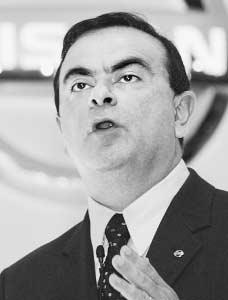Carlos Ghosn
1954–
President and chief executive officer, Nissan Motor Company
Nationality: French.
Born: March 9, 1954, in Brazil.
Education: École Polytechnique, 1974; École des Mines de Paris, 1978.
Career: Michelin Corporation, 1978–1981, employee; 1981–1984, plant manager; 1984–1985, head of research and development of earthmover and agricultural tires; 1985–1989, chief operating officer of South American activities; 1989–1990, president and chief operating officer of North American companies; 1990–1996, chairman, president, and chief operating officer of Michelin North America; Renault Corporation, 1996–1999, executive vice president; Nissan Motor Company, 1999–2000, chief operating officer; 2000–2001, president; 2001–, president and chief executive officer; Renault Corporation, 2005–, chief executive officer.
Address: Nissan Motor Company, 17-1 Ginza 6-chome Chuo-ku, Tokyo, 104-8023, Japan; http://www.nissandriven.com.
■ In 2001 Brazilian-born Carlos Ghosn became the first non-Japanese person to head a major Japanese automobile-manufacturing corporation. As the president and chief executive officer of Nissan Motor Company, he broke the traditional Japanese business models that had stifled the automaker's growth. Within two years Ghosn had led the faltering company into a period of revival, breaking a ten-year string of losses or tiny profits. By the end of the first quarter of 2003, Nissan turned a profit of more than $4 billion. Involving himself in all aspects of the company, from designing to test driving, Ghosn made himself an icon for Japanese business culture by the middle of his second year in office. Ironically, he did so while breaking with many cherished Japanese traditions and protocols: closing plants, laying off workers, and cutting ties with suppliers that did not meet his standards.
Ghosn trumped his achievements at Nissan by becoming the only person to head two automakers on two continents.

He was tapped to follow Louis Schweitzer, his former boss at Renault Corporation, in hopes that he could repeat the successes he had in Japan at Renault's headquarters in France. Part of that success involved the development of common manufacturing practices, platforms, engine designs, and transmissions and other parts between the two automakers. Renault (which owned 44 percent of Nissan when Ghosn became head of the Japanese company) and Nissan also planned to coordinate such disparate functions of their business as forecasting sales, benchmarking manufacturing processes, and lowering the costs of warranties.
MAKING TRACKS IN THREE CONTINENTS
Ghosn (his last name rhymes with "own") was born in Brazil but moved to France in his teens and received his education at the prestigious French schools of the École Polytechnique and the École des Mines de Paris. After completing his second degree, Ghosn began a successful career at Michelin, then Europe's top tire manufacturing and marketing firm. In 1981, only three years after he joined the company, he was promoted to plant manager at the company's Le Puy facility. In 1984 he became the head of research and development of earthmover and agricultural tires in Ladoux. The following year he left France, returning to his native continent to become Michelin's chief operating officer of South American activities. In 1989 he became president and chief operating officer of North American companies, and in 1990 he was promoted to chairman of Michelin North America.
MAKING WAVES IN JAPAN
Ghosn left Michelin for new challenges at Renault, headquartered in Boulogne Billancourt, France. He served as executive vice president for three years before being sent to Tokyo to oversee Nissan Motor Company. Renault had just bought a controlling interest in the Japanese automaker, and Ghosn was dispatched to Tokyo in hopes that he would be able to bring Nissan's spiraling costs under control. Within months of his arrival Ghosn had laid bare a plan that would not only revolutionize the way business was done at Nissan but challenge some of the basic assumptions that lay at the heart of Japanese business methods. By shutting down plants, laying off workers, and severing ties with underperforming suppliers, Ghosn demonstrated that radical measures could be effective in changing the conservative Japanese business system. He expected the process of making Nissan profitable to take three years; it took only two.
Ghosn also changed the look of Nissan's line of automobiles. The leading Japanese automakers, Honda and Toyota, historically were cautious about altering the appearance of their cars. In contrast, Ghosn, according to Alex Taylor in Fortune , took risks by making over almost one-third of Nissan's product line within a couple of years. "Ghosn wants Nissan to stand for passionate innovation," said Taylor, "and insists that new products satisfy an unmet customer need" (July 21, 2003). The executive's record, the Fortune contributor concluded, seemed to forecast great things for the companies he headed.
See also entries on Nissan Motor Co. and Renault S.A. in International Directory of Company Histories .
sources for further information
"Carlos Ghosn, Nissan CEO," Time , http://www.time.com/time/2001/influentials/ybghosn.html .
"Carlos Ghosn, Nissan Motor," BusinessWeek Online , http://www.businessweek.com/2001/01_02/b3714015.htm .
Fonda, Daren, "He Did So Well, Let's Give Him Two CEO Jobs: Carlos Ghosn Renault," Time , December 1, 2003, p. 78.
Greising, David, "Nissan CEO Carlos Ghosn Lets Team Drive Turnaround," Chicago Tribune , November 25, 2002.
"Meet the People behind the Cars," Inside Nissan http://www.nissanusa.com/insideNissan/CorporateBiographies .
Meredith, Robyn, "Encore," Forbes , April 26, 2004, p. 72.
Taylor, Alex, III, "Nissan Shifts into Higher Gear: Carlos Ghosn Has Revved Up Profits at the Japanese Automaker. Now He Wants to Go Faster," Fortune , July 21, 2003, p. 98.
—Kenneth R. Shepherd